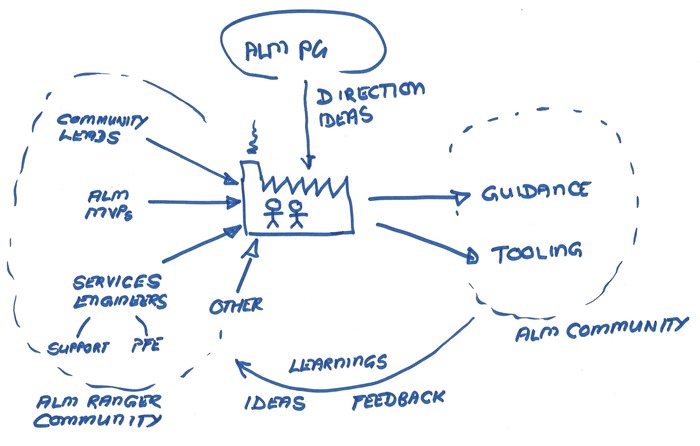Time-slicing through a context-switching vortex and proposing a cookbook
Few realise the huge sacrifice many ALM Ranger community members are making for the ALM community. With the exception of two Program Managers, all of us are part-time volunteers, investing an average of 15 min/day timeslice, excluding other community contributions, such as forums, events and trying to keep up with the technology storm. A lot of context switching between family, job, community gigs and the Rangers. Not a lot of time from a project bandwidth planning perspective, but a huge “family time” commitment by the volunteers. Did we mention that everyone also has a real job, which introduced our family>job>rangers mantra.
the core factory of the community
Before we get to the cookbook, let us first focus on our factory, coordinated by Anisha Pindoria and I. The factory receives input (new ideas, experiences, revisions,…) from both the product group and he ALM community. This input is triaged, analysed and converted into guidance and/or tooling solutions by the ALM Ranger community. This community consists predominantly of part-time volunteers from the ALM Community, ALM MVPs and Microsoft Services, bringing a wealth of passion and experience in technology, real-world experience, and an independent view.
The real-world experience and independent view, combined with the aka.ms/only15min constraint, is where the cookbook idea emerged during one of my strolls through the Ladner farm lands today to clear my mind. During the same walk, I noticed a few stunning beauties of nature that visualise an important quote, as well as two solution types:
 |
 |
 |
| Now this is not the end. It is not even the beginning of the end. But it is, perhaps, the end of the beginning. —Winston Churchill | Out-of-band solution. |
Extensibility solution. |
cookbook idea
So, how do we harvest the real-world experience, solutions created to address in-the-field issues, without overloading the ALM Rangers, who often do not have the time or energy to join part-time projects that run for a few sprints and often have a roadmap with milestones attached?
- How do we enable the engineers, often referred to as “brains on a stick”, to share their invaluable knowledge with the rest of the ALM Community, sharing leanings and avoiding duplication and waste?

- We allow the engineers to make a note of the issue, solution and other useful information, without having to invest time or worry about formatting, styles and pedantic reviewers.
We allow them to literally take notes on a tissue (napkin in Canada) or a cigarette box, or dump their brain during a 1:1 phone call.
All we ask for is:- Description of the problem or question
- Summary of the solution.
- Prerequisites.
- Sketch of the problem and/or solution … seeing is believing!
- References.
- The factory, as mentioned above, turns the rough notes into a one-page quick reference card.
- At some point, the quick reference cards are packaged as a cookbook and shared with the community.
- The ALM Community can submit new or revised content by cloning the cookbook and submitting a Pull Request to accept changes.
Value proposition
- Engineers can and will share problems and questions they encounter on in the field, together with their solution and evidence, without having to commit too much “family time”.
- Community can eventually share updates or problems and questions they have encountered.
- Everyone has a cookbook to deliver some awesome solutions, that enable and excite users.
Feels like a WIN:WIN for all involved!?!
3-step quick reference card prototype
Here is an example of a quick reference card, addressing a common question we encounter: “which version control system should I select”?
- Using Microsoft Word, the issue/question, solution, prerequisites, reference and a visualisation are captured on one page.
- If it does not fit on the page, link to more detailed information, such as documentation, forum / blog post(s) and solutions.
- The sample quick reference card point to MSDN and a CodePlex solution.
- Run a PowerShell script which iterates through all Microsoft Word based documents and converts them to markdown using Pandoc.
- User can view the quick reference card in the markdown client of their choice.
Not included in the three (3) steps above, is the checkpoint, merger of quick reference cards and publishing of the cookbook in markdown and PDF formats.
thoughts?
We can’t wait to hear from you. Here are some ways to connect with us:
- Add a comment below.
- Contact me on my blog.

